How many calories are spent when running is a question that is asked by those who want to lose weight and are thinking about choosing a method for losing weight.
We'll tell you where calories come from and how many are burned when running, how much time you need to run to lose weight, and how to increase the effectiveness of your running training.
What are calories and where do they come from?
A person's weight gain directly depends on the number of calories that enter his body. The balance of calories consumed and burned allows you to maintain normal weight and not gain extra pounds. When losing weight, the balance should shift towards the calories you burn: that is, you should take in less than you burn.
It seems that this is obvious and simple, but many people are mistaken in this too. To effectively lose weight, it is not enough to exercise a lot - if this causes you to consume even more calories, then no amount of exercise will help you quickly lose those extra pounds.
To create your diet, you need to know your daily calorie intake. Here is a convenient calculator for calculation
How can running help us? Running workouts are primarily cardio exercise. During them, the body can spend both fats and carbohydrates. Energy metabolism with the greatest use of fat will occur while running at a medium pace - this is the pace that is the best way to run for weight loss.
There is a myth that the faster and harder you run, the more calories you will burn. As your running intensity increases, your body will begin to use carbohydrates for fuel, and, at some point, will begin to use them exclusively. However, there is one caveat.
The “oxygen debt” effect that occurs after an intense workout allows you to burn calories for another 48 hours. The body tries to recover after exercise and spends more oxygen on it. During this period, you can additionally lose up to 500 kcal.
The total amount of calories burned during an intense workout will be significant. But these calories will not go away all at once, as when jogging, but with some time delay.
Features of interval running
If we talk about cardio, like running and walking activities, then interval running is considered the most effective for losing weight - alternating high, medium and low tempos over a distance. Due to this, the body experiences both high loads on the route, thereby burning calories, and goes through short periods of rest, recovering for a new breakthrough.
How does interval running affect human health? There are several key points here:
- Increased calorie consumption occurs. During such training, the body experiences severe stress, akin to panic, which forces it to produce more energy;
- The athlete gradually accustoms himself to a high, intense pace, increases the load and copes with it;
- Increases endurance and speed over long distances;
- The leg muscles develop and acquire beautiful athletic shapes;
- The amount of subcutaneous fat decreases and is replaced by growing muscle tissue;
- Metabolism accelerates, which leads to rapid cell renewal.
How many calories are burned in 15, 30 and 60 minutes of running?
For each person, the calories burned during running will be individual. It depends on your metabolism and many other factors. Approximate numbers will be as follows:
- In 15 minutes of running at a pace of 6 min/km, a person weighing 60 kg will spend about 150 kcal;
- In 30 minutes of running at a pace of 6 min/km, a person weighing 60 kg will burn 320 kcal;
- For 45 minutes of running at the same pace - 470 kcal;
- For 60 minutes of running at the same pace - about 650 kcal.
How much should you run to lose weight?
The body begins to use up fat reserves only after 20 minutes of running. Therefore, long running workouts will be especially effective for losing weight.
The duration of the workout depends on your goals and fitness level. For 1 km of jogging at an average pace, in 7 minutes a person loses about 250 kcal. Cool weather will also be a plus - the body will begin to spend calories on increased heat production.
When covering a distance of 2 km in 12 minutes, a person loses about 350 kcal. Remember that a person’s body mass index should not be higher than 35, otherwise the joints and heart muscle are subjected to heavy load.
If you decide to run 3 km, then your body mass index should be no more than 30. Having covered this distance in 15 minutes, a person loses about 500 kcal. It is better to do such jogging in the summer in hot weather - a large amount of liquid will be consumed, which interferes with fat burning.
Not everyone can do a running workout with a distance of 4-5 km. In order to run such a distance at a good pace, a high level of physical fitness is required. Beginners are not recommended to run such distances. If you manage to run this distance in 20-25 minutes, you can lose about 800 kcal.
Read more about how to start running - tips for beginner runners.
How to start running outside to lose weight
In addition to being an effective way to lose weight (with the right approach), running outside makes it simple and convenient—something you can do almost anywhere with minimal equipment.
One big downside to running for weight loss, or just running in general: it's high-impact and hard on the joints of your lower extremities.
While running can increase bone density in your legs—this puts more stress on them and forces your legs to quickly adapt to new stress—it can also carry a high risk of injury, especially in the lower extremities, especially for beginners who are unaccustomed to strong, repetitive nature of the movement.
Fortunately, by taking certain precautions, you can greatly increase your chances of staying healthy. One helpful measure is to start with a small number of runs and separate runs over 48 hours to give the tissues of the lower extremities a chance to adapt to the repeated impacts.
Don't worry: a little jogging outside for weight loss can lead to big fat loss if
you keep the intensity high and combine it with strength training and a healthy, portion-controlled diet.
Basic rules to help you lose weight while running
- Regular training is very important. The effect will be achieved only when the body is accustomed to constant stress. Choose a few days a week, preferably 3 or 4, determine your training time and follow the schedule;
- There is no need to try to take Everest right away - start with such distances that you can do and at which running does not cause inconvenience and discomfort;
- Start tracking your calories - there are plenty of apps to make this process easier;
- Don't limit yourself to running - the body will gradually adapt to running loads and the effect of them will decrease. You can connect other cardio workouts - exercise machines, jumping rope, swimming, cycling;
- The diet should contain a minimum of fats and carbohydrates, read more in the article Diet for weight loss;
- If you feel very tired or feel unwell after training, stop exercising for a while or reduce its intensity;
- Running in the morning will help you get a boost of energy for the rest of the day.
Find the right shoes
Choosing the right shoes will further reduce the likelihood of injury. Always run in shoes designed specifically for your activity. But not all running shoes are good for every runner; Some runners need more cushioning, others less. Some do better with shoes that have special stability characteristics, others not so much.
To find the best shoes for you, shop at a specialty running store with staff trained to match runners with the best-fitting shoes.
But don't put yourself completely in the hands of the experts. Research shows that runners are less likely to get injured when they choose the most comfortable shoe from a range of options—so listen to your feet, as well as the salesperson helping you. In addition to trying to avoid injury, beginners should focus on staying motivated. Consider signing up for an event, such as a 5K race. Many beginners find that the goal of crossing the finish line motivates them to keep running the way a weight loss goal does because it gives them a specific goal to work towards and a deadline to achieve it. You may initially view running outdoors for weight loss as nothing more than a way to lose a few pounds, but over time you may just fall in love with it forever.
What is more effective - walking or running?
Intuitively, walking is less efficient than running. But it is much simpler and does not require a high level of physical fitness. Below are tables that contain information about the number of calories burned when walking and running for people of different weights. The training duration is taken to be 60 minutes.
Efficiency of burning calories when walking:
Weight, kg
| Speed, km/h | 60 | 65 | 70 | 75 | 80 | 85 | 90 | 95 | 100 |
| 3 | 145 | 157 | 169 | 182 | 195 | 208 | 222 | 235 | 250 |
| 4 | 182 | 196 | 210 | 225 | 239 | 255 | 271 | 288 | 305 |
| 5 | 210 | 227 | 244 | 262 | 281 | 300 | 320 | 340 | 361 |
| 6 | 262 | 21 | 300 | 320 | 340 | 361 | 384 | 407 | 430 |
| 7 | 342 | 370 | 399 | 430 | 462 | 495 | 529 | 561 | 597 |
Calorie burning efficiency when running:
Weight, kg
| Speed, km/h | 60 | 65 | 70 | 75 | 80 | 85 | 90 | 95 | 100 |
| 8 | 480 | 520 | 665 | 715 | 770 | 830 | 895 | 965 | 1040 |
| 10 | 600 | 650 | 755 | 815 | 880 | 950 | 1025 | 1105 | 1190 |
| 12 | 720 | 780 | 840 | 905 | 970 | 1040 | 1110 | 1185 | 1260 |
| 14 | 840 | 905 | 970 | 1040 | 1110 | 1185 | 1260 | 1340 | 1420 |
| 16 | 960 | 1030 | 1100 | 1170 | 1245 | 1320 | 1400 | 1480 | 1565 |
What conclusion can be drawn from these tabular data? The efficiency of running is on average 2-2.5 times higher than walking. However, heavy people find it difficult to walk long distances, so walking can be a good alternative for them.
Contraindications to running for weight loss
Before you start running to lose weight, take the time to visit a general practitioner to find out if you have any contraindications. Overweight people tend to have more contraindications than others.
It is forbidden for people with heart disease, hypertension, bronchial asthma, or peptic ulcers to run. It is necessary to temporarily stop exercising after abdominal surgery. It is not recommended to run a lot for people with second or more degrees of varicose veins.
Read next: How to start running: a complete guide to running for beginners
What can you do to lose weight more effectively from running?
There are several nuances that will help increase the effectiveness of running training.
- For the greatest effect, the running pace should be intervals or jerky. This is the pace that will be most useful when losing weight. At the beginning of your run, take your normal speed and roll into running work. Then, at certain intervals, accelerate for a short period of distance. Repeat such accelerations throughout the entire distance, returning after them to the initially selected running pace;
- Hand movements will help enhance the effect - you can move them both to the rhythm of running and wave them above your head. Additional stress on the body will speed up the burning of calories;
- The running technique involves lifting your feet off the ground and raising your knees. The higher you raise them, the more stress the body experiences, therefore, it spends more calories;
- For best results, you can use hilly or mountainous terrain for running. If there are no hills nearby, you can run up the steps;
For example, for a person weighing 70 kg, the energy consumption while running up the stairs will be as follows:
- 5 minutes of running – 90 calories burned;
- 10 minutes of running – 180 calories burned;
- 15 minutes of running – 270 calories burned;
- 20 minutes of running – 360 calories burned;
- 30 minutes of running – 540 calories burned;
- 45 minutes of running – 810 calories burned;
- 1 hour of running – 1070 kilocalories burned.
Semyon Zhdanov
Master Trainer of Outdoor programs at World Class
Is there a fundamental difference between morning and evening running?
It is important to consider a person's lifestyle. Most likely, after the morning training, a full day of work awaits him. And he doesn’t need to kill himself in such a way that his body will be broken all day. Therefore, in the morning you need to start running slowly, gradually increasing the speed, but it should still be comfortable for the body. Running in the evening is different in that a person goes for a run after a full day of work. And you need to understand why he runs in the evening. Sometimes you don’t want to train, your motivation drops, but all these are illusions. When you start running, be sure to warm up first, blood flow will increase and fatigue will go away. You will even get rid of stress. But you shouldn’t go too far during an evening run: the nervous system may become overexcited, so it may be difficult to fall asleep.
When does the body burn more calories?
Of course, in the first half of the day, since our metabolism is accelerated and we are very active during this period of time. And if you also worked out in the morning, then burning calories occurs faster and more efficiently. But it’s worth taking into account the fact that the most calories are burned when we add wood to the stove: that is, we need to eat often and little by little, approximately every three hours. Then we will burn calories faster. You also need to understand what calories we burn: be it fat or glycogen in muscles. Pulse zones are already taken into account here, and, for example, if you train at low intensity, that is, it lasts from 60 to 90 minutes, you will be able to burn calories from fat. They first burn in the muscles, then, when we continue to be active during the day, eat often and the right foods (but this is a separate topic), the body begins to pull out subcutaneous fat and remove it into the muscles. This is how fat calories are burned.
How often and for how long should you run?
The question is interesting and rhetorical, but there are already some general developments. If we take the average person, less active, for example, an office worker or someone else with a sedentary lifestyle, then the frequency should be two to three times a week. This is an approximate minimum.
Duration from 30 to 90 minutes. And this should last for the rest of your life, since running is an innate quality, like eating or washing your face. Then the body will be healthy and strong. But here you need to take into account some points that running often and for a long time can be perceived by a person as special exhaustion of his body. Therefore, it is possible to alternate running with walking: run for a minute, walk for a minute. There is no need to make this a hard workout or challenge for yourself. Of course, you can occasionally strain yourself, but overall, running should be a pleasure and a joy.
What to do if you feel bad after a morning run?
You need to look for the reason: how a person runs, how long he trains, whether he exercises on an empty stomach or not, whether he gets enough sleep or goes to a bar in the evenings. To cope with poor health, you need to do the following: stay hydrated throughout the day and eat regularly. That is, you will find breakfast, lunch and dinner with snacks in between. If it becomes very bad, then try to set aside an hour during the day to rest (especially from gadgets). Of course, after this, take action, monitor your running and, perhaps, switch to walking in the future.
Why do most professional athletes prefer to run in the morning?
For almost all people, jogging in the morning is a ritual, exercise, and an opportunity to tune in for the day ahead. Professional athletes may still have at least two workouts per day. Therefore, a morning jog is just exercise, then they rest for two hours, and then they do the first workout, also for two hours. Then they rest again, have dinner and sleep. In the evening they go out for the second training session. If we talk about professional runners, they run three times a day with a heavy load.









